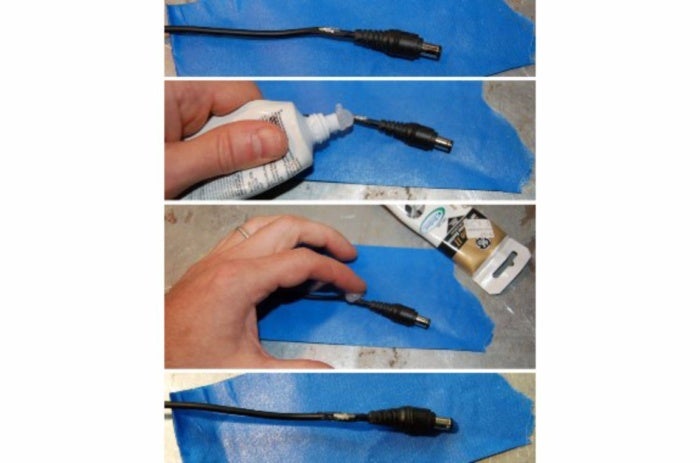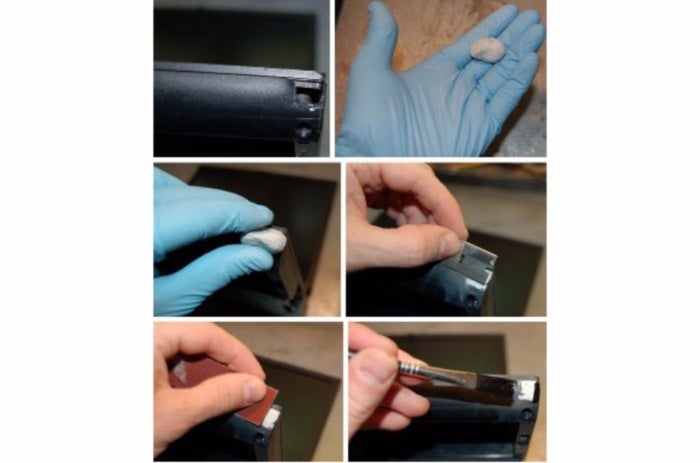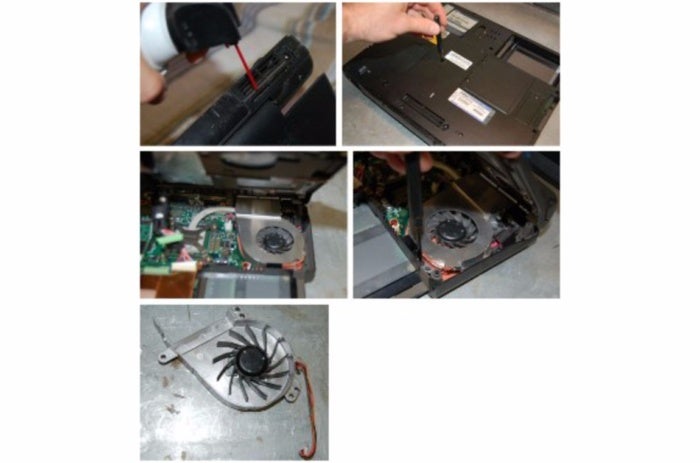We live and work in a cold, cruel world where our laptops can take a lot of abuse. Regardless of how gentle we try to be, our notebooks will probably be dropped, spilled upon or worse—sooner, if not later.
But if you think that all notebook damage can be repaired only by the manufacturer or a computer shop, think again. Many problems can be inexpensively and easily fixed with common tools, spare parts, and a little effort. Some repairs are no harder than high school art projects. That said, there are modern laptops that are very difficult to open and repair. If you can’t see any screws, you’re in for a tough time.
Using a couple of old, beat-up mainstream notebooks, we'll show you how to fix everything from a broken case and frayed charger cord to a bad fan and scratched screen. Each restoration project has time and cost estimates, as well as what materials you'll need to do the trick. Just follow the basic directions we've outlined for each repair.
Fair warning: Your system might be a little different, require special parts, or need a slightly different approach. YouTube is your friend.
One additional note: While we generally applaud improvisation and recycling old parts (especially AC adapters), there's nothing like having the precisely correct part to do the repair. In fact, while fans and notebook keyboards may look similar, they can be very different. Each repair features links to where you can get the right parts, but they are just a sample of what's available. If all else fails, try eBay, Newegg, Amazon, or CDW to get what you need.
Problem: Frayed AC adapter cord
Cost: $5 to $15
Time: 1 to 2 hours
Materials: Silicone sealant, painter's tape (which is less sticky than regular masking tape), protective gloves (optional)
Because a notebook that travels needs to be plugged in and unplugged several times a day, the cord and connector can take a beating, leading to a frayed or otherwise damaged power cord. If this happens, it's important to get a new cord or fix it right away, because it not only can damage the system's battery through intermittent charging, but it can also be a fire hazard.
Fortunately, many laptop power adapters have removable AC power cords, which cost a few dollars and are available online or at electronics stores. On the other hand, if the connector that plugs into the computer is the problem, it can cost $50 to $75 to replace if you opt for the exact AC adapter for your laptop from your notebook manufacturer, Amazon, or eBay (search for your make and model name followed by "AC adapter").
Or you can just fix it yourself.
 Brian Nadel/IDG
Brian Nadel/IDGA frayed power cord can be dangerous. Apply silicone sealant to the frayed cord.
The quick-and-dirty repair for a frayed cord is to wrap electrical or duct tape over the damage. This prevents further damage, but over time will come loose—not to mention leaving that sticky gunk all over the cable when it does.
A better way is to make a more permanent repair with silicone sealant, available at any hardware store and many supermarkets, which will insulate and protect it. It's best to use black to match the cord's color, but clear sealant works just as well.
To protect the surface you're working on, lay down a wide strip of painter's tape, sticky side down, and place the frayed area of the cord on top of it. The sealant won't stick to the back of the painter's tape the way it might to other barriers made out of paper or plastic, and the painter's tape should peel right off the table when you're done. (Note, however, that you shouldn't be doing any kind of computer repairs on your good furniture.)
Next, squeeze out a gob of sealant onto the area that needs fixing. Work the gooey sealant into place, covering the damage with a liberal coating. If you have sensitive skin, it's a good idea to wear thin protective gloves for this part.
Let the sealant cure for an hour or two until it is firm. Gently remove the cord from the tape (and the tape from the table), and you have the equivalent of a new power cord that's flexible and ready for years of road work.
Problem: Cracked laptop case
Cost: $15
Time: 2 to 3 hours (20 minutes to set up the repair, 5 minutes to place and shape the putty, an hour or two to let it cure, 10 minutes to sand it, 30 minutes to paint it and let it dry)
Materials: Epoxy putty, sandpaper, razor blade, Sharpie marker or paint, gloves (optional)
When notebooks get dropped, more often than not they land on the corner, one of the weakest parts of the case. Unless you have a ruggedized notebook, there's a good chance that after an encounter with gravity, the corner will be cracked or—as was the case with my laptop—broken through completely.
It happened in an airport holding pen some time ago, when I sneezed while typing an email. The system went flying and smacked into the floor. Before I got home, I put a bandage over the damaged area to keep the elements out. Now it's time to fix it for real.
The secret is to use epoxy putty to fill in the broken part of the case. Epoxy putty is available online or at any hardware store for around $4 to $6 a tube, so you can even do this repair on the road. The brand of putty you choose doesn't matter, but avoid the quick-setting variety because it might harden before you're done.
First, make sure the damaged area is clean and free of dirt and loose pieces.
 Brian Nadel/IDG
Brian Nadel/IDGPutty, sanding, and trimming can fix a hole in a laptop case.
Then it's time to prepare the putty. It comes as a cylinder with two components wrapped around each other. Just cut a section off and twist the parts together.
The key to a smooth case repair is to mix the two components together thoroughly in your hands. Because the putty hardens as the result of a chemical reaction between the two parts, it's important that they are completely blended together. You might want to use gloves for this part, because some people are sensitive to the chemicals in the putty.
Try rolling the putty into a long cylinder and then folding it over itself several times. After a few minutes, the putty becomes a uniform white or gray, and you're ready.
You'll feel like a kid working with Play-Doh, and in fact, the putty should be the consistency of Play-Doh, which is perfect for working it into the damaged area. Press it firmly into the hole in the case and use your finger or a razor blade to shape it to follow the contour of the case. When it covers the area, take the flat side of a razor blade or back of a ruler and compress the outer surface to flatten it. Any excess putty can be wiped off the case with paper towel before it dries.
When you like the way it looks, go do something else for an hour or two until the epoxy is cured. When it has hardened, the epoxy patch is just as strong as the plastic case.
Many DIYers stop here, and use the obvious repair as a road warrior's badge of honor or conversation starter on road trips. I prefer a little more finishing, so I smooth the epoxy with 150- and then 220-grit sandpaper. Then I give it a final sanding with 2,000-grit paper that is slightly wet to remove any surface scratches.
Naturally, the color doesn't match. If it's a small repair, try using a Sharpie marker to cover it up. For this repair, I used model airplane enamel paint, which costs about $5 for a small bottle (a full set of colors with brushes is $10). When it's dry, the repair is done and visible only if you look closely.
Problem: Bad laptop fan
Cost: $15 to $25
Time: 1 hour
Materials: Screwdriver, compressed air, vacuum, replacement fan
A noisy or non-functional cooling fan is not only annoying but doesn't bring enough cooling air into the case, potentially causing the notebook to overheat and damage the electronics inside. It's not a hard repair to do, though, and if you're lucky you may not need to replace the fan at all.
My laptop has a single cooling fan, although many systems, particularly larger gaming and entertainment systems, have two or more fans to circulate air over the processor, graphics hardware and hard drive. More often than not, the fans get clogged with dust, debris and dirt, which can make them noisy and lower their efficiency. If your system is making a whirring or grinding noise or is overheating, this repair is for you.
Before you do anything else, find the place(s) where fresh air comes in and hot air escapes—usually one or more slotted grilles on the side or bottom of the system. There could be two or three vents, so search thoroughly. Insert the plastic straw from a can of compressed air into each vent and blow out all the dust that you can. You might want to put on a dust mask or have a vacuum cleaner running, because there can be a disgusting amount of dust. Optionally, or additionally, you can try sucking things out with a canister vacuum cleaner.
If this doesn't fix things, it's time to dig deep and open the case. There are generally about a dozen screws on the bottom of the case that you'll need to remove to open the case, but it varies widely depending on the notebook. For instance, some models require you to remove the keyboard to get inside. If it's not immediately obvious, check your user's guide or do some online research (again, YouTube is great for this stuff) to find out how your case opens.
 Brian Nadel/IDG
Brian Nadel/IDGBlow compressed air into the slotted grilles. Open the case and remove any dust or detritus that impedes the fan. Carefully remove the old fan.
After carefully opening the case, find the fan and blow away any additional dust or detritus.
While you're there, take a good look for anything stuck in the fan's blades that might be impeding it. Twirl the blade with your finger. If it makes noise or doesn't spin freely—as was the case with my laptop—it needs to be replaced.
Before going further, write down the model number of the fan and go online to find a replacement fan. Use your favorite search engine and type in the model number and "cooling fan." Chances are that even for a five- or six-year-old computer, there will be fans available from eBay or the odd vendor. The replacement should cost anywhere from $5 to $20.
Once you have the new fan in hand (and are sure it's the right one), you can take out the old fan. First, unplug the fan's power connector. Each system is different, but you'll probably need to unscrew a frame that holds the fan in place, and then undo some screws holding the fan to the frame. Again, the user's guide or online videos are a great help.
Now you can gently remove the fan. It might take a little finesse to work the fan loose, because it's generally a tight fit in there. Many notebook fans are connected to the heat pipe, a thin silver- or copper-colored tube that draws heat off of the processor or graphics chip. The heat pipe usually snaps or screws into the fan assembly. Try not to bend the heat pipe when you're removing the fan, because that will reduce its efficiency at cooling the processor.
If for some reason, you go too far and can see the bare top of the CPU, make sure there's adequate thermal paste. This is required to transfer heat from the CPU to the heat sink, and the lack of paste can also cause overheating issues. A tube costs a couple of bucks.
With the new fan ready to go, slip it in and carefully screw everything back in place. Before you screw the bottom of the case back on, plug in the power connector and fire up the machine. Don't worry if the fan doesn't start right away, because it may turn on only after the system heats up. Once you've verified that it's working, close up the machine and get to work.
Read on for solutions for stuck keys, scratched displays, and sticky spills.
Không có nhận xét nào:
Đăng nhận xét